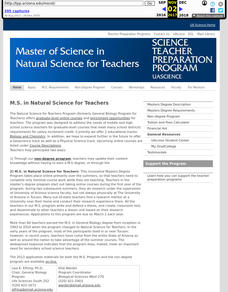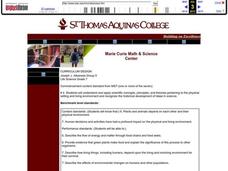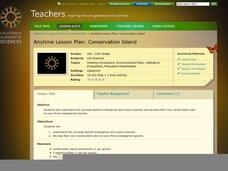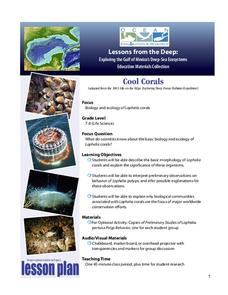Curated OER
A Walk in the Woods
Students observe an environment, ask questions about what they observe. and design experiments to answer one question they came up with in this upper-level High School or college lesson. The lesson requires an outdoor exploration or...
Curated OER
Laws of the Jungle
Students build a video game on predator-prey relationship. In this biology lesson, students identify the variables that affect this relationship. They write a short description and play each other's game.
Curated OER
The Chain Gang
Young scholars perform a food chain simulation to determine what happens when a food chain is broken.
Curated OER
Spiders: An Organism for Teaching Biology
In this unit, the students explore basic ecology concepts and scientific processes using spiders as model organisms. They capture spiders, observe and care for them, and use them to answer their own questions about spider behavior....
Curated OER
Insect Biology and Ecology: A Primer
Students explore insects and closely related organisms. They examine the growth and development of a lady beetle. Students classify insects and organize them. They investigate pest management.
Curated OER
South of the Border Down Brooklyn Way
Students use the Internet to research the behavior and ecology of feral monk parakeets. They design a monk parakeet behavioral study, then post their results to a Web page.
Curated OER
The Rain Forest
Students acquire knowledge about the basics of the tropical rain forest ecosystem. They analyze the cause/effect relationship between humans attitudes and behavior and the evnvironment. Students list the four general layers of vegetation...
Curated OER
Desert Animals
Students survive within an ecosystem, an animal must be physically and behaviorally adapted to the conditions of its environment.
Curated OER
Jurassic Park Debate
Students research behavior, phsyiology, and ecology of dinoaurs. Students role-play as scientific specialists such as geneticists and ecologists. They present their research findings in a research paper.
Curated OER
Predator-Prey Relationships
Learners understand ecological systems. They provide experiences to assist citizens to increase their sensitivity and stewardship for the environment.
Curated OER
Invertebrate Research Project
Young scholars keep a scientific research notebook on an invertebrate detailing its behavior and responses.
Curated OER
A Reef of Your Own
Students study the reproductive strategies of reef building corals. In this coral reef lesson plan students describe the behaviors of reef building corals and their nutritional strategies.
Curated OER
Eco-Graphics - Photographic Studies of Man's Impact on the Environment
Students, in groups, explored and photographed their own community disposal problems, focusing on the impact of waste disposal behaviors, laws, systems, and management.
Curated OER
Are There Too Many Elk?
Students use information about elk populations in Arizona to make recommendations about population management. In this ecology lesson, students discover the problems associated with having a heard of elk that is too large. After...
Curated OER
FLY HIGH!!!
Students create their own bird study in their own schoolyard using the scientific method (see Testing a Hypothesis in Join the Project). Students do research in the library, at a local college, or on the Internet to determine the...
Curated OER
Adaptations To the Environment
Young scholars design and construct an imaginary animal that is perfectly adapted to a particular type of biome. They give the animal a scientific name, place it in a phylum and write descriptions about its behavior, reproduction,...
Curated OER
Explore the Food Web
Young scholars identify plants and animals in the journals of Lewis and Clark's expedition. They describe the various animal habits. Students interpret the behaviors of the animals discovered on the expedition. They design a food web...
Consortium for Ocean Science Exploration and Engagement (COSEE)
Arctic Smorgasbord
Though the walrus spends roughly one third of its time on land, it eats organisms that live on the bottom of the ocean. The first in a series of five, the lesson uses a variety of plant and animal cards to have scholars build an arctic...
Curated OER
Plants and Animals
Seventh graders discover the interconnectedness of plants and animals in ecosystems. In groups, they create a food web and discuss the problems when one link of the chain is broken. To end the lesson, they set up a balanced environment...
California Academy of Science
Conservation Island
Why not walk in the footsteps of Teddy Roosevelt and become a conservationist? After discussing issues and reasons for animal extinction, the class creates their own conservation plans. Each small group is given mock data regarding a...
EnLiST
Trap Your Own Insects: What’s in Your Backyard?
Young entomologists construct three types of insect traps—pitfall, pollinator, and panel—before setting their traps out and observing what they caught. They then observe what types of insects the different traps attract.
NOAA
Deep-Sea Ecosystems – Cool Corals
Young oceanographers research deep sea corals that thrive on chemosynthesis. The lesson plan focuses on the biology of the animal, preferred habitat, associations, and interactions.
Curated OER
Sour and Bitter: Acids and Bases
Tenth graders distinguish between acids and bases. In this pH lesson, 10th graders view a PowerPoint and discuss the characteristics of an acid and a base. They investigate natural substances to determine the pH level of each.
Kenan Fellows
The Little Stuff Can Make a Big Difference
Great things come in small packages! What better way to illustrate this point than a week-long look at nanotechnology? Earth science scholars explore water quality issues through lab activities, then research new innovations in nanotech...























